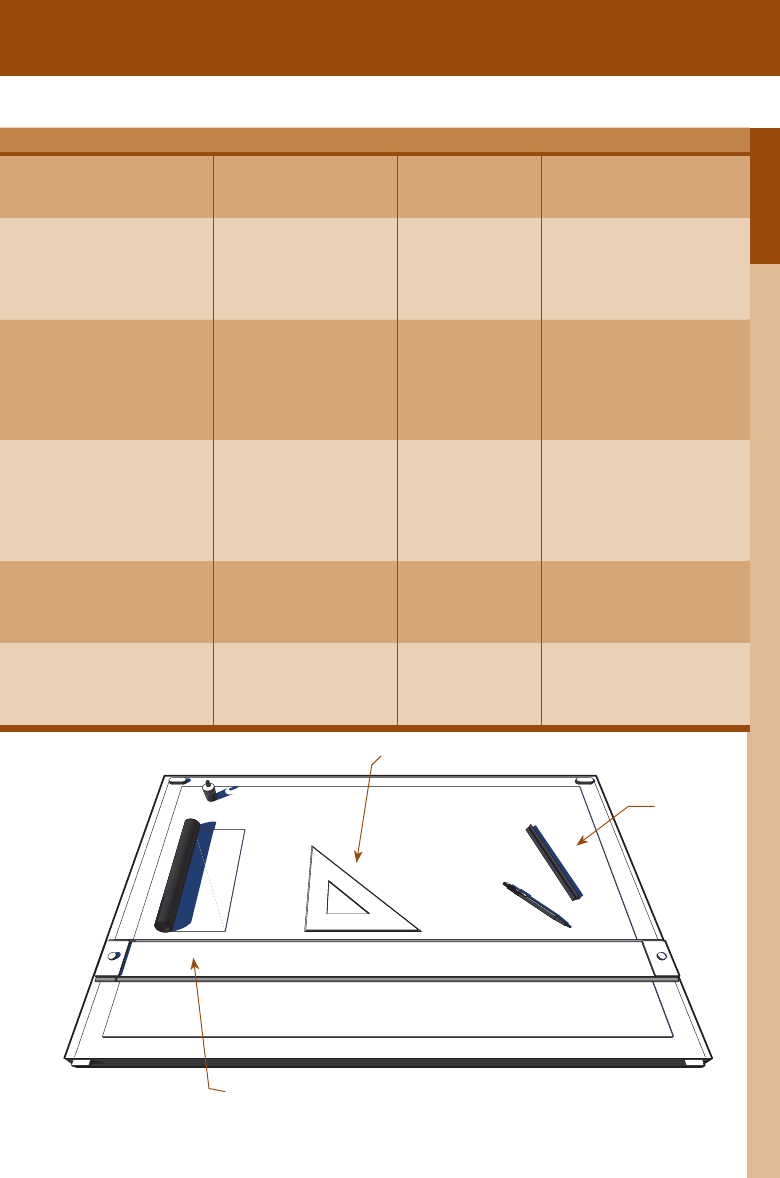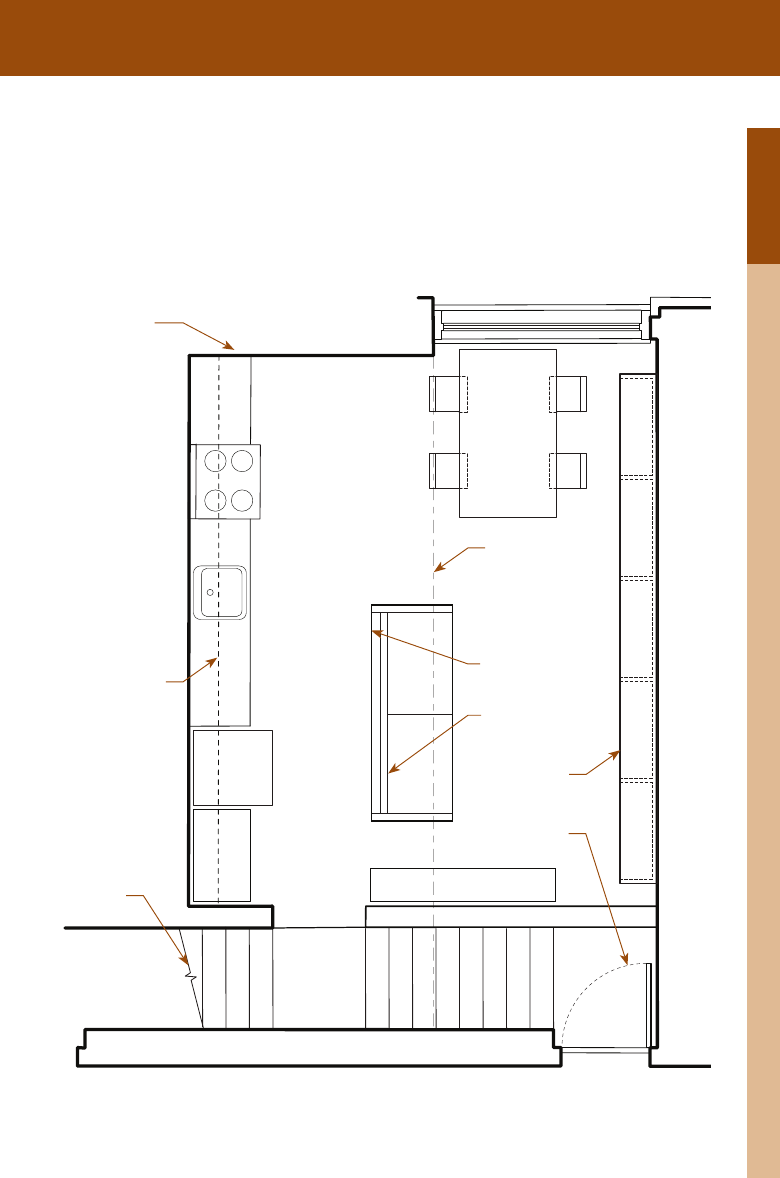
03
Job:02-30056 Title: RP-Interior Design Reference and Specification
#175 Dtp:216 Page:29
Job:02-30056 Title: RP-Interior Design Reference and Specification
#175 Dtp:216 Page:28
(RAY)
024-057_30056.indd 29 3/4/13 7:22 PM
29
Drawing Basics
Text
triangle
drafting board
parallel rule
is often used for developing quick ideas and details, and is still employed quite frequently for
lead holder
architect’s scale
Paper Description Sizes Best Use
Tracing Paper thin, transparent paper
that comes in white or
yellow
rolls in standard
drafting sizes (12",
18"
, 24", and 36")
sketching and drafting de-
tails; overlay work; pencil,
ink, and marker
Vellum thicker than trace; avail-
able in various weights
(16, 20, and 24 lbs.);
transparent and smooth
nish
sheets and rolls construction documents;
hard-line detail drawings;
perspective drawings;
pencil, ink, and marker.
Drafting Film often referred to as
Mylar; one- or two-sided
drawing surface; of its
various weights .003
and .004 are the most
common
sheets (in stand-
ard drafting sizes)
and rolls (36" and
42")
construction documents;
plastic lead and ink; erases
well and is resistant to
tearing.
Bond opaque paper that
comes in a variety of
thicknesses and n-
ishes of which hot- and
cold-pressed are the
most common
sheets of varying
sizes
nal drawings; pencil,
though ink and watercolor
can be used on certain
papers
Illustration Board nish paper laminated
to a cardboard backing;
comes in single ply (
1
/
16
")
and double ply (
3
/
32
")
sheets of varying
sizes
nish presentation draw-
ings; model making
Foam Core polystyrene core faced
with clay papers; comes
in a variety of thick-
nesses
sheets up to 48"
x 96"
quick model studies; dry
mounting presentation
boards
millimeters diameter; a spring-push action
Leads in various hardnesses; good for drawing or sketching on tracing
provides an edge that can move in one direction on a drawing surface.
-degree
Job:02-30056 Title: RP-Interior Design Reference and Specification
#175 Dtp:216 Page:29
Job:02-30056 Title: RP-Interior Design Reference and Specification
#175 Dtp:216 Page:28
(RAY)
024-057_30056.indd 29 3/4/13 7:23 PM

03
Job:02-30056 Title: RP-Interior Design Reference and Specification
#175 Dtp:216 Page:30
(RAY)
024-057_30056.indd 30 3/4/13 7:22 PM
30
THE INTERIOR DESIGN REFERENCE + SPECIFICATION BOOK
Text
UNDERSTANDING DRAWING CONVENTIONS
For legibility and comprehension, designers employ a number of graphic conventions in their
drawings that communicate the designs equally to clients, consultants, and contractors. In a
necessary abstraction, lines, symbols, and text all combine to convey the designer’s vision.
LINE WEIGHTS AND TYPES
Lines are essential to the communicative language of an interior designer. Lines convey a
project’s intended plan, demonstrate the sectional quality of the space, and visually cue
the reader to matters of hierarchy, type, and intent. Line weights and types can be created
through various media, both manually and digitally.
Line types have many functions in an interior drawing. The designer determines the relative
meaning for different weights; however, heavier lines are typically reserved for plans and sec-
tion cuts, while lighter lines form the outlines of surfaces and furniture within a room.
Dashed lines represent many different elements, from objects that are hidden from view to
objects above the cut plane (e.g., cabinets above kitchen counters), from the type of wall
construction to changes in level. They can also be tied to consultant trades, showing, for
example, structural grids, electrical wiring, lighting and switching, or mechanical routing.
Hierarchy
Here the walls that are cut are the most heavily rendered; furniture and built-ins are lighter;
and hidden elements such as shelving and cabinetry are expressed with dashed lines.
Heavy
Used for borders of drawings, profiles of objects,
and cut lines in plans and sections.
0.05" (1.27)
0.04" (1.02)
0.03" (0.76)
0.025" (0.64)
Medium and Light
Used for dimensions, lines on objects that are
not in the cutting plane, and objects hidden from
view.
0.014" (0.36)
0.007" (0.18)
0.003" (0.08)
Dashed
Dashed .5x
Dash-dot-dash
Dashed
Used for hidden objects, either above or below the
cutting plane.
heavy outline
for cut object
dash indicating
objects above
break line
Job:02-30056 Title: RP-Interior Design Reference and Specification
#175 Dtp:216 Page:30
(RAY)
024-057_30056.indd 30 3/4/13 7:23 PM

03
Job:02-30056 Title: RP-Interior Design Reference and Specification
#175 Dtp:216 Page:31
Job:02-30056 Title: RP-Interior Design Reference and Specification
#175 Dtp:216 Page:30
(RAY)
024-057_30056.indd 31 3/4/13 7:22 PM
31
Drawing Basics
Text
drawings that communicate the designs equally to clients, consultants, and contractors. In a
meaning for different weights; however, heavier lines are typically reserved for plans and sec-
Hierarchy
in a plan drawing is established through the careful use of line weights and types.
Here the walls that are cut are the most heavily rendered; furniture and built-ins are lighter;
and hidden elements such as shelving and cabinetry are expressed with dashed lines.
Used for borders of drawings, profiles of objects,
not in the cutting plane, and objects hidden from
Used for hidden objects, either above or below the
heavy outline
for cut object
dash indicating
objects above
dash indicating
objects above
dash indicating
object hidden
from view
medium line showing
perimeter of object
medium line showing
line within object
dash indicating
swing of door
break line
Job:02-30056 Title: RP-Interior Design Reference and Specification
#175 Dtp:216 Page:31
Job:02-30056 Title: RP-Interior Design Reference and Specification
#175 Dtp:216 Page:30
(RAY)
024-057_30056.indd 31 3/4/13 7:23 PM

03
Job:02-30056 Title: RP-Interior Design Reference and Specification
#175 Dtp:216 Page:32
(RAY)
024-057_30056.indd 32 3/4/13 7:22 PM
32
THE INTERIOR DESIGN REFERENCE + SPECIFICATION BOOK
Text
DRAWING SYMBOLS
Drawing symbols provide a codified language by which to specify the essential
elements in drawings across a set. Below are some of the symbols typically
used for an interior set.
standard drawing
identier
enlarged detail
reference
interior
elevation
wall or detail
section
column grid
drawing label
revision cloud
and number
break line
window type
door type
wall type
centerline
room tag
wall coverings
wall nishes
Symbols on a plan drawing are keyed to other drawings in the set
plans, elevations, sections, and details. Elements needed to implement a design are thus
easily read from drawing to drawing, and revisions are readily coordinated. Dimensions are
indicated in strings around the plan, or in some cases, within the plan itself. Legibility of text
and numbers is crucial to reading a plan.
oor coverings
lighting xture
NUM
SHEET
NUM
SHEET
NUMBER
NAME
NUM
SHEET
4
3
2
1
A
1
DRAWING NAME
SCALE
2
1
1
C
L
1
1
1
NUM
SHEET
1
3
2
1
Job:02-30056 Title: RP-Interior Design Reference and Specification
#175 Dtp:216 Page:32
(RAY)
024-057_30056.indd 32 3/4/13 7:23 PM

03
Job:02-30056 Title: RP-Interior Design Reference and Specification
#175 Dtp:216 Page:33
Job:02-30056 Title: RP-Interior Design Reference and Specification
#175 Dtp:216 Page:32
(RAY)
024-057_30056.indd 33 3/4/13 7:22 PM
33
Drawing Basics
Text
Symbols on a plan drawing are keyed to other drawings in the set
, including reected ceiling
plans, elevations, sections, and details. Elements needed to implement a design are thus
easily read from drawing to drawing, and revisions are readily coordinated. Dimensions are
indicated in strings around the plan, or in some cases, within the plan itself. Legibility of text
and numbers is crucial to reading a plan.
4
3
2
NUM
SHEET
NUMBER
NAME
NUM
SHEET
NUM
SHEET
1
1
3
2
1
A
1
B
2
DRAWING NAME
SCALE
DN
DIMENSION
Job:02-30056 Title: RP-Interior Design Reference and Specification
#175 Dtp:216 Page:33
Job:02-30056 Title: RP-Interior Design Reference and Specification
#175 Dtp:216 Page:32
(RAY)
024-057_30056.indd 33 3/4/13 7:23 PM
..................Content has been hidden....................
You can't read the all page of ebook, please click here login for view all page.
